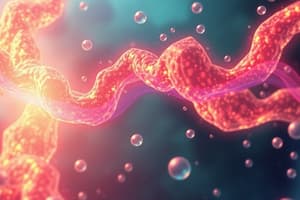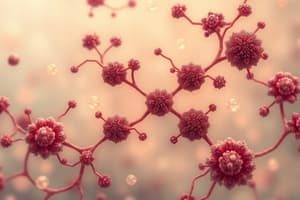Podcast
Questions and Answers
What does pharmacokinetics primarily investigate?
What does pharmacokinetics primarily investigate?
- The chemical structure of the drug
- What the body does to the drug (correct)
- What the drug does to the body
- The side effects of the drug
Which of the following processes is NOT part of pharmacokinetics?
Which of the following processes is NOT part of pharmacokinetics?
- Distribution
- Activation (correct)
- Absorption
- Elimination
Why do we often measure drug concentrations in plasma or serum?
Why do we often measure drug concentrations in plasma or serum?
- They correlate with tissue concentrations (correct)
- They are easier to obtain than tissue samples (correct)
- They are the only reliable sources
- They represent the drug's efficacy
What is the primary role of the drug during the absorption phase of pharmacokinetics?
What is the primary role of the drug during the absorption phase of pharmacokinetics?
What is plasma derived from?
What is plasma derived from?
Which term represents the four processes involved in pharmacokinetics?
Which term represents the four processes involved in pharmacokinetics?
Which of the following statements regarding drug metabolism is correct?
Which of the following statements regarding drug metabolism is correct?
What might be a reason to measure drug concentration in the brain for headache treatment?
What might be a reason to measure drug concentration in the brain for headache treatment?
What mathematical concept is emphasized as important for making dosing regimen decisions?
What mathematical concept is emphasized as important for making dosing regimen decisions?
What is a primary focus of the class mentioned in the content?
What is a primary focus of the class mentioned in the content?
Why might some students find the initial review of basic mathematical rules boring?
Why might some students find the initial review of basic mathematical rules boring?
What is the expected outcome from applying pharmacokinetic models in this course?
What is the expected outcome from applying pharmacokinetic models in this course?
What aspect of variability is highlighted as important for dosing regimens?
What aspect of variability is highlighted as important for dosing regimens?
What factor may lead to a greater variability in drug response compared to pharmacokinetics?
What factor may lead to a greater variability in drug response compared to pharmacokinetics?
Which of the following might contribute to drug pharmacodynamic variability?
Which of the following might contribute to drug pharmacodynamic variability?
What is therapeutic drug monitoring primarily used for?
What is therapeutic drug monitoring primarily used for?
What approach involves adjusting dosage based on the patient's genomic information?
What approach involves adjusting dosage based on the patient's genomic information?
Which situation would NOT typically require therapeutic drug monitoring?
Which situation would NOT typically require therapeutic drug monitoring?
How does tolerance development affect drug dosing?
How does tolerance development affect drug dosing?
What is the main purpose of pharmacogenomic studies in medication management?
What is the main purpose of pharmacogenomic studies in medication management?
What could be a consequence of having a receptor mutation?
What could be a consequence of having a receptor mutation?
Which type of drug would most benefit from therapeutic drug monitoring?
Which type of drug would most benefit from therapeutic drug monitoring?
Which term refers to genetic variations that may affect disease treatment?
Which term refers to genetic variations that may affect disease treatment?
In therapeutic drug monitoring, what factors are measured to adjust dosing?
In therapeutic drug monitoring, what factors are measured to adjust dosing?
Drug-drug interactions primarily influence pharmacodynamics when two drugs bind to which?
Drug-drug interactions primarily influence pharmacodynamics when two drugs bind to which?
What can lead to ineffective drug responses due to dosage?
What can lead to ineffective drug responses due to dosage?
What is the primary reason for using serum or plasma concentrations to make dosing decisions?
What is the primary reason for using serum or plasma concentrations to make dosing decisions?
Which of the following statements accurately describes the therapeutic window?
Which of the following statements accurately describes the therapeutic window?
What is inter-individual variability in drug response?
What is inter-individual variability in drug response?
Which factor is NOT mentioned as a source of pharmacokinetic variability?
Which factor is NOT mentioned as a source of pharmacokinetic variability?
What is the role of the liver in drug elimination?
What is the role of the liver in drug elimination?
Why might a patient experience variability in drug concentrations despite receiving the same dosing regimen?
Why might a patient experience variability in drug concentrations despite receiving the same dosing regimen?
What happens when drug concentrations fall below the therapeutic window?
What happens when drug concentrations fall below the therapeutic window?
What can lead to pharmacodynamic variability in patients?
What can lead to pharmacodynamic variability in patients?
How does an increase in gastric pH affect the absorption of an acidic drug?
How does an increase in gastric pH affect the absorption of an acidic drug?
What strategy might be employed for patients with concentrations at risk of toxicity?
What strategy might be employed for patients with concentrations at risk of toxicity?
What could be a potential consequence of failing to monitor a patient's drug concentrations?
What could be a potential consequence of failing to monitor a patient's drug concentrations?
What is the main method through which the kidneys eliminate drugs?
What is the main method through which the kidneys eliminate drugs?
Which of the following is NOT a factor contributing to pharmacokinetic variability?
Which of the following is NOT a factor contributing to pharmacokinetic variability?
What is one method to address inter-individual variability in dosing?
What is one method to address inter-individual variability in dosing?
What is the primary purpose of centrifuging clotted blood?
What is the primary purpose of centrifuging clotted blood?
How do immediate release formulations differ from slow release formulations?
How do immediate release formulations differ from slow release formulations?
What is pharmacodynamics primarily concerned with?
What is pharmacodynamics primarily concerned with?
What does pharmacogenomics study?
What does pharmacogenomics study?
Why are drug concentrations measured in serum or plasma rather than tissues?
Why are drug concentrations measured in serum or plasma rather than tissues?
What is the main goal when designing a dosing regimen?
What is the main goal when designing a dosing regimen?
What type of relationship is depicted in the pharmacodynamics graph?
What type of relationship is depicted in the pharmacodynamics graph?
What is the effect of higher concentrations of a drug on side effects?
What is the effect of higher concentrations of a drug on side effects?
What does the term 'biopharmaceuticals' refer to?
What does the term 'biopharmaceuticals' refer to?
What factor does pharmacodynamics assess regarding drug effects?
What factor does pharmacodynamics assess regarding drug effects?
Which of the following best describes pharmacokinetics?
Which of the following best describes pharmacokinetics?
What outcome is associated with high initial concentrations of a drug?
What outcome is associated with high initial concentrations of a drug?
How does a mutation in a metabolic enzyme impact medication response?
How does a mutation in a metabolic enzyme impact medication response?
What role does biopharmaceuticals play in drug administration?
What role does biopharmaceuticals play in drug administration?
In maintaining the efficacy and safety of drug therapy, what is crucial for drug dosing?
In maintaining the efficacy and safety of drug therapy, what is crucial for drug dosing?
Which genetic mutation affects the metabolism of clopidogrel?
Which genetic mutation affects the metabolism of clopidogrel?
What should be done if a patient is identified as a poor metabolizer of codeine?
What should be done if a patient is identified as a poor metabolizer of codeine?
What genetic test is available for assessing hypersensitivity to abacavir?
What genetic test is available for assessing hypersensitivity to abacavir?
In the context of warfarin therapy, which genes are important for dosing decisions?
In the context of warfarin therapy, which genes are important for dosing decisions?
How does pharmacokinetics relate to drug therapy?
How does pharmacokinetics relate to drug therapy?
What effect does the metabolism of tramadol have on its analgesic action?
What effect does the metabolism of tramadol have on its analgesic action?
What is the primary concern if a patient is a poor metabolizer of CYP2D6?
What is the primary concern if a patient is a poor metabolizer of CYP2D6?
Which of the following drugs may need to be stopped if a genetic variant indicating hypersensitivity is present?
Which of the following drugs may need to be stopped if a genetic variant indicating hypersensitivity is present?
Which of the following factors is NOT typically considered when optimizing drug dosing?
Which of the following factors is NOT typically considered when optimizing drug dosing?
What is the main purpose of pharmacogenomic testing in drug therapy?
What is the main purpose of pharmacogenomic testing in drug therapy?
What class of medications does warfarin fall into?
What class of medications does warfarin fall into?
If a patient shows a mutation in CYP3A4, which of these drugs could be affected?
If a patient shows a mutation in CYP3A4, which of these drugs could be affected?
What type of drugs require a narrow therapeutic index?
What type of drugs require a narrow therapeutic index?
Which tool can help optimize dosing regimens in drug therapy?
Which tool can help optimize dosing regimens in drug therapy?
Flashcards
Pharmacokinetics (PK)
Pharmacokinetics (PK)
The study of how the body affects a drug, including its absorption, distribution, metabolism, and elimination.
Drug Absorption
Drug Absorption
The process by which a drug enters the bloodstream after being administered.
Drug Distribution
Drug Distribution
What happens to a drug after it enters the bloodstream, including its movement to different tissues and organs.
Drug Metabolism
Drug Metabolism
Signup and view all the flashcards
Drug Elimination
Drug Elimination
Signup and view all the flashcards
Plasma
Plasma
Signup and view all the flashcards
Serum
Serum
Signup and view all the flashcards
Drug Concentration
Drug Concentration
Signup and view all the flashcards
Pharmacodynamics
Pharmacodynamics
Signup and view all the flashcards
Biopharmaceuticals
Biopharmaceuticals
Signup and view all the flashcards
Pharmacogenomics
Pharmacogenomics
Signup and view all the flashcards
Efficacy
Efficacy
Signup and view all the flashcards
Adverse Effects
Adverse Effects
Signup and view all the flashcards
Exposure-Response Relationship
Exposure-Response Relationship
Signup and view all the flashcards
Centrifugation
Centrifugation
Signup and view all the flashcards
Supernatant
Supernatant
Signup and view all the flashcards
Maximum Concentration (Cmax)
Maximum Concentration (Cmax)
Signup and view all the flashcards
Pharmacokinetics
Pharmacokinetics
Signup and view all the flashcards
Slow Release Formulation
Slow Release Formulation
Signup and view all the flashcards
Immediate Release Formulation
Immediate Release Formulation
Signup and view all the flashcards
Therapeutic Window
Therapeutic Window
Signup and view all the flashcards
Inter-individual Variability
Inter-individual Variability
Signup and view all the flashcards
Pharmacodynamics (PD)
Pharmacodynamics (PD)
Signup and view all the flashcards
Pharmacokinetic Variability
Pharmacokinetic Variability
Signup and view all the flashcards
Pharmacodynamic Variability
Pharmacodynamic Variability
Signup and view all the flashcards
Body Size, Gender, and Race Variations
Body Size, Gender, and Race Variations
Signup and view all the flashcards
Renal and Hepatic Function
Renal and Hepatic Function
Signup and view all the flashcards
Pharmacokinetic Model
Pharmacokinetic Model
Signup and view all the flashcards
Optimized Dosing Regimen
Optimized Dosing Regimen
Signup and view all the flashcards
Variability
Variability
Signup and view all the flashcards
Half-Life
Half-Life
Signup and view all the flashcards
Tolerance Development
Tolerance Development
Signup and view all the flashcards
Therapeutic Drug Monitoring
Therapeutic Drug Monitoring
Signup and view all the flashcards
Prospective Dose Adjustment
Prospective Dose Adjustment
Signup and view all the flashcards
Pharmacokinetic Polymorphism
Pharmacokinetic Polymorphism
Signup and view all the flashcards
Pharmacodynamic Polymorphism
Pharmacodynamic Polymorphism
Signup and view all the flashcards
Single Nucleotide Polymorphism (SNP)
Single Nucleotide Polymorphism (SNP)
Signup and view all the flashcards
Agonist
Agonist
Signup and view all the flashcards
Antagonist
Antagonist
Signup and view all the flashcards
Narrow Therapeutic Index Drug
Narrow Therapeutic Index Drug
Signup and view all the flashcards
Placebo
Placebo
Signup and view all the flashcards
Pharmacogenomic testing
Pharmacogenomic testing
Signup and view all the flashcards
CYP2C19 mutation
CYP2C19 mutation
Signup and view all the flashcards
Drug hypersensitivity
Drug hypersensitivity
Signup and view all the flashcards
Pharmacogenomic app
Pharmacogenomic app
Signup and view all the flashcards
Codeine metabolism and CYP2D6
Codeine metabolism and CYP2D6
Signup and view all the flashcards
Study Notes
Pharmacokinetics (PK)
- Deals with what the body does to a drug
- Involves drug absorption, distribution, metabolism, and elimination (ADME)
- Often focuses on drug concentrations in plasma/serum
- Plasma is derived from unclotted blood (using anticoagulants like heparin or EDTA)
- Serum is derived from clotted blood (allowing clotting to occur naturally)
- Plasma/serum concentrations often correlate with tissue concentrations, allowing for dosing decisions
Pharmacodynamics
- Deals with what a drug does to the body
- Focuses on relationships between drug concentration at the site of action and the effect (desired and adverse)
- Aims to find the therapeutic window (concentration range with desired effects and minimal side effects)
Biopharmaceuticals
- Studies the effect of dosage forms on pharmacokinetics
- Immediate release formulations lead to rapid drug concentration increases in the bloodstream
- Slow release formulations lead to slower drug absorption, lower maximum concentrations, but longer duration in the bloodstream
Pharmacogenomics
- Studies how a person's genes affect their response to medication
- Can identify genetic variations (SNPs) that can impact drug metabolism
- Can be used to optimize dosing regimens (higher or lower doses)
Exposure-Response Relationships
- Graph showing drug concentration (x-axis) vs effect (y-axis)
- Sigmoidal curves for both therapeutic effects and side effects
- Therapeutic window is the concentration range where the desired effect is seen without significant side effects
- Variability among patients leads to diverse concentration-time profiles, making it necessary to adjust dosing regimens to fit individual needs
Inter-Individual Variability
- Differences in drug responses among patients due to various factors (gender, race, body weight, renal/hepatic function)
- Also due to drug-drug interactions, environmental factors, disease states, and patient compliance
- Pharmacogenomic information can be used to predict inter-individual differences and tailor dosing
Therapeutic Drug Monitoring
- Monitoring drug levels in patients to adjust dosing regimens for drugs with narrow therapeutic windows (e.g., digoxin, aminoglycosides, phenytoin)
Retrospective vs. Prospective Dose Adjustments
- Retrospective involves monitoring drug levels after administration to adjust future doses
- Prospective involves using pharmacogenomic information to predict drug response and adjust doses before treatment begins
Studying That Suits You
Use AI to generate personalized quizzes and flashcards to suit your learning preferences.




